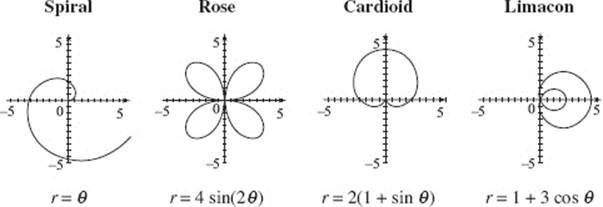Calculus AB and Calculus BC
CHAPTER 1 Functions
G. POLAR FUNCTIONS
Polar coordinates of the form (r, ![]() ) identify the location of a point by specifying
) identify the location of a point by specifying ![]() , an angle of rotation from the positive x-axis, and r, a distance from the origin, as shown in Figure N1–14.
, an angle of rotation from the positive x-axis, and r, a distance from the origin, as shown in Figure N1–14.

FIGURE N1–14
A polar function defines a curve with an equation of the form r = f (![]() ). Some common polar functions include:
). Some common polar functions include:

EXAMPLE 17
Consider the polar function r = 2 + 4 sin ![]() .
.
(a) For what values of ![]() in the interval [0,2π] does the curve pass through the origin?
in the interval [0,2π] does the curve pass through the origin?
(b) For what value of ![]() in the interval [0,π/2] does the curve intersect the circle r = 3?
in the interval [0,π/2] does the curve intersect the circle r = 3?
SOLUTION:
(a) At the origin r = 0, so we want 2 + 4 sin ![]() = 0. Solving for
= 0. Solving for ![]() yields
yields ![]() which occurs at
which occurs at ![]()
(b) The curves r = 2 + 4 sin ![]() and r = 3 intersect when 2 + 4 sin
and r = 3 intersect when 2 + 4 sin ![]() = 3, or
= 3, or ![]() From the calculator we find
From the calculator we find ![]() = arcsin
= arcsin ![]()

FIGURE N1–15
A polar function may also be expressed parametrically:
x = r cos ![]() , y = sin
, y = sin ![]()
In this form, the curve r = 2 + 4 sin ![]() from Example 17 would be defined by:
from Example 17 would be defined by:
x(![]() ) = (2 + 4 sin
) = (2 + 4 sin ![]() ) cos
) cos ![]() , y(
, y(![]() ) = (2 + 4 sin
) = (2 + 4 sin ![]() ) sin
) sin ![]()
EXAMPLE 18
Find the (x, y) coordinates of the point on r = 1 + cos ![]() where
where ![]()

Chapter Summary
This chapter has reviewed some important precalculus topics. These topics are not directly tested on the AP exam; rather, they represent basic principles important in calculus. These include finding the domain, range and inverse of a function; and understanding the properties of polynomial and rational functions, trigonometric and inverse trig functions, and exponential and logarithmic functions.
For BC students, this chapter also reviewed parametrically defined functions.